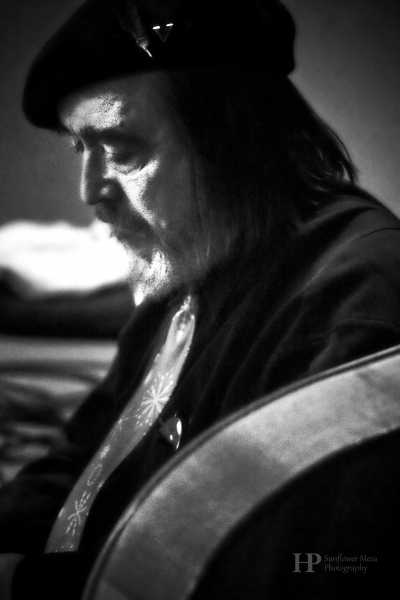Black and white portrait taken at a Contra Dance in December of 2018 [Full Image]. The subject was a Scottish musician playing piano for the dancers. Dances are wonderful places to capture dynamic and joyous portraits of people in motion. Taking photos at a Contra Dance was suggested by a friend, and something I had never done before. It worked out really well, despite photographic conditions not being the best...
The lighting was rather poor, with the musicians and dancers moving quickly under yellow florescent lights. I was using the Sony a6000 camera with the Sony E 55-210mm kit telephoto lens which has a wide aperture of between F 4.5 and F 6.3 depending on the focal length. Because the dancers and musicians are constantly moving, a fast shutter speed keeps the action from becoming a blur. With only these limited and not so wide open apertures available, a shutter speed of 125 or 250 required pushing the ISO up into the 6000 range to capture the dim indoor motion. The resulting photos were expectantly underexposed, but not blurry. With such a high aperture comes image noise which appears as grain in the photo. Sometimes the grain is unacceptable, but sometimes you can work with grain and integrate it into the look of the final photo. Grain can set a mood.
I returned from the dance and reviewed about 50 RAW format photos, I liked the composition of this one. But, it had some problems:
- Underexposed.
- Lots of image noise (grain) due to the high ISO.
- Focus was less than perfect.
- A bass violin obstructed the foreground.
Regardless, I liked the composition, and it seemed salvageable.
I brought the 24mb RAW image into my post processing program, Phase One Capture One Pro 12, and started working with it, trying different image variants. I had just upgraded to this newest version of Capture One the day before, and this was the first image I worked with, and I wanted to try out a new feature - Luma Masking.
The path to the final image went something like this. First I dropped image saturation to zero - this removed all color information and resulted in a black and white image. I then increased the contrast of the image overall . I created several masks: a background mask that allowed me to blur out the background around the subject, a foreground mask that allowed me to further blur the obtrusive bass fiddle that was in the foreground, and a face make which I was able to sharpen and pull some detail from the subjects face. For this face mask I used the new Luma Mask feature. The Luma mask allows you to select a range of exposure from dark to light, and really lets you get right at objects like faces, and selectively apply process tools. Because of the underexposure and high ISO, the face tended toward a grainy look, so I further emphasized that by adding soft grain with a larger diameter. I exported the image as full resolution JPG. Then, using Photoshop, I further upped the contrast in with the NIK Silver EFX Pro filter and then gave a bit of a vignette using the NIK Color EFX Pro 4 Darken Lighten Center filter.
I saved the changes and noticed that the image had taken on a somewhat painterly look, which I strive for. Compositionally it works. The subject has an interesting face, is dressed in a traditional Scottish outfit, and has a rather reflective expression. The blurred bass fiddle draws the eye into the photo, and the visual line to the interesting face continues with the tie. The highlights on the face draw the eye. The background does not distract. The grain sets a pensive mood.
More images from the Contra Dance are available here.
